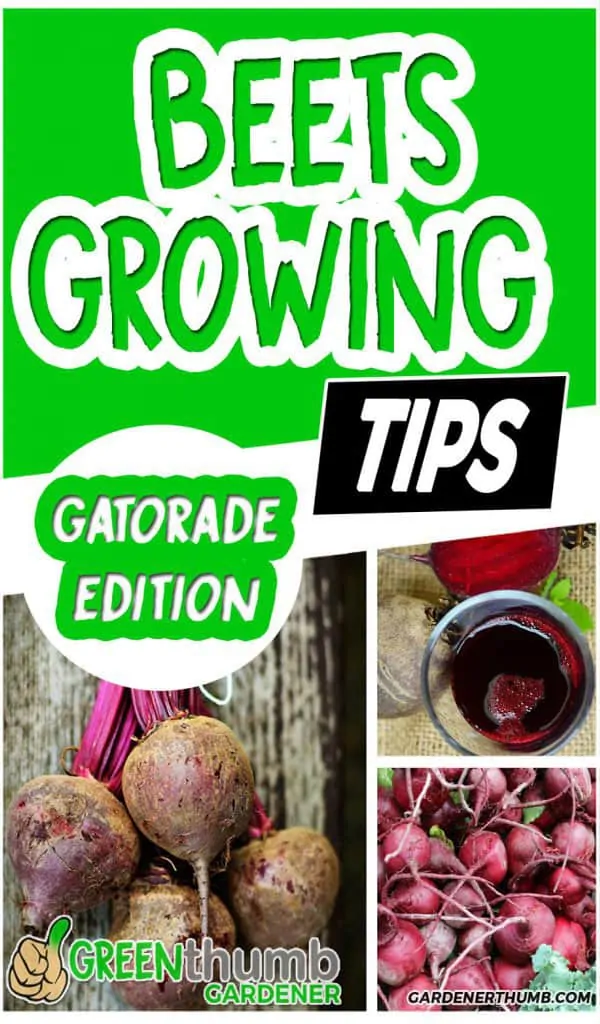Growing Beets | Gatorade Sports Performance Fuel
Last updated: 10/30/21
Did you grow up eating pickled beets and want to relive your childhood memories? Have you always wanted to grow beets in your garden? Is your favorite salad mixed with arugula, beets, and goat cheese?
Growing beets is the perfect way to culminate your desire to satisfy these needs. Beets are a perfect root vegetable that is so easy to grow and taste like no other vegetable. It has an earthy component to it that makes it a unique flavor for on your plate.
Some cultures even believe that a beet that a man and woman shares will create an endless love between them. Eating beets are even shown to help you stay together with some increased sexual drive.
You either love beets or you don’t. It is funny because I am the only one in my house that cares for them. In fact, I just juiced one with some carrots and celery and had a beet salad for lunch because I had an insatiable craving for beets as I have been researching and writing about beets for a few days.
Growing beets is fairly simple and easy to do. It and can be grown in the spring and fall months. Beet seeds germinate best in soil temperatures of 75° F, so you can warm up the soil a few days before you sow with plastic to give them a head start during cooler weather.
Beets grow best when spaced about 2-5 inches apart. Beets require constant, even watering throughout its growing cycle. Beets require a good amount of soil nutrients to grow well, so rotted compost or aged manure is suggested. Beets can be harvested for their roots or the beet greens. Harvesting of beets usually takes approximately 8 weeks from seed to table.
Green thumb Gardener occasionally links to product and/or services offered by vendors to assist you with all your gardening needs. Some of these may be affiliate links, meaning we earn a small commission if items are purchased.
Want to Download a Garden Hack Guide for FREE

Enter your email below and we will send you a guide to help you SAVE money in your garden.
Beet History
Beets (Beta vulgaris) has a rich history over the years. Hippocrates used leaves of beetroot for binding and dressing wounds. Beets were used for medicinal purposes throughout the Middles Ages.
The Romans ate beetroots as a laxative and to alleviate fever symptoms. It was even thought that eating beets would enable you to live longer. It is funny how there was a gap in these beliefs as science has caught up that beets are a superfood.
Originally, beets were harvested for their long thin green leaves. The Greeks cultivated beetroot around 300 BC. They didn’t use the roots of the plant and only ate the leaves.
They nevertheless respected the root and offered it to the sun god Apollo in the temple of Delphi.
Many cultures used found many culinary uses for beets. Borscht is a popular beetroot soup in Eastern and Central Europe. Poland has an interesting mix of beetroot and horseradish for a culinary mix called ćwikła.
Today, beets are harvested for sugar production as they are dense with sugar content.
Growing Beets for Sports Performance
You might like roasted beets to add to your salads or you love juicing them. Beets are one of those root vegetables that is versatile for your cooking to give you that earthy flavor you are looking for.
Growing beets is one of the best ways to provide your family with fresh foods. Picking up any juicing book and you will see that beets are a cornerstone in a good healthy juicing recipe. Here are some of the benefits of growing beets to eat:
- Promotes Detoxification – Studies have shown that consuming beet juice or consuming beets can increase liver functions by flushing out certain toxins. Your liver is the organ responsible for helping your body clear out toxins and detoxify your body. Betaines, in beets, stimulate the functions of the liver and keep it healthy. Grow some beets for your liver’s sake.
- Boost Immunity – Beets contain a dense array of nutrients to help to boost your immunity levels in the body. Beets contain a healthy dose of Vitamin C, vitamin B-complex, and powerful antioxidants to help fight fever and colds. Healthy amounts of these vitamins help to eradicate fatigue, soothe minor aches, and reduce inflammation.
- Act as Aphrodisiac– Beets contain vast amounts of boron. An increase in boron can lead to a higher production of testosterone level in males. It also improves the production of estrogen in some women. This can lead to a boost in your libido, increased fertility, and sperm mobility improvement. Who would think that growing beets to add to your diet would help in the bedroom?
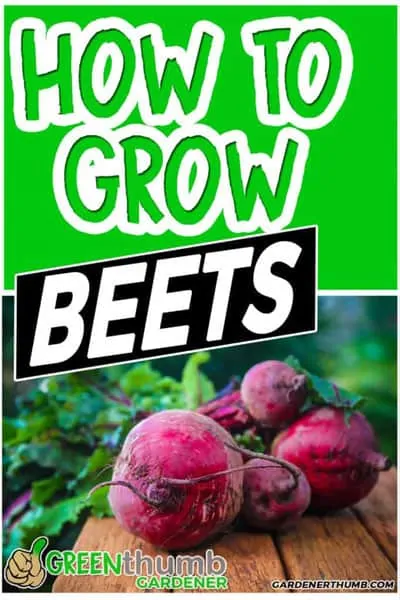
- Boost Athletic Performance– Consuming a good amount of beets is shown to improve running performance in healthy adults. In one study, researchers found that athletes who drank beet juice increased their oxygen uptake by up to 16%. Beet juice has shown to improve athletic performance in runners, swimmers, and cyclists, making it an interesting sports drink that most people would never consider. Growing beets as a Gatorade replacement is not a stretch to say.
Step by Step Guide on How to Grow Beets
Materials Need for Planting Beets
- Beet Seeds– We highlighted some of our favorite varieties of beets to grow below. Make sure you check the days to harvest on your particular beet variety to ensure you plan the time needed
- Fertilizer or compost– Giving beets a good start of NPK is definitely needed for optimal growth. It is best to start with a balanced fertilizer with an NPK ratio of at least a 10:10:10 to 14:14:14.
- Container (optional) – This guide focuses on planting beets directly in your garden from seed. However, beets plants do well in containers of at least 14 inch deep and at least 18 inches in diameter for most varieties of beets. Keep in mind that beets roots grow 12-14 inches deep, so get the deepest container you can.
Steps to Grow Beets
- You want to make sure that your daytime temperatures are at least 50°F- 60°F for your area before sowing your beet seeds. Roughly about 4 weeks before your last frost date
- Start by locating a space in your garden that you want to plant your beets in. Ideally, a place that has full to partial sun is best for beets.
- Work in your compost or fertilizer into the soil prior to planting. This will promote growth for your beets plants because they need lots of nutrients. The beet taproots run deep so make sure there is plenty of compost for at least 5-6 inches
- Stick your finger or a stick into the soil to create a 1/2 inch hole to drop your beet seed in.
- Space each plant at least 2-4 inches apart spaced in rows spaced at least 1-2 feet apart. You will get bigger beets the further you space them apart (4″ or more), but can still get good-sized ones at 2 inches apart.
- Lightly cover the beet seeds with some shifted soil & water in.
- Mulching is highly suggested for beets plants to help control the moisture levels, especially during hot periods.
- It is recommended to let the beet plants sprout & grow for 14 days before you add liquid fertilizer to your beet plants. They do well with a good seaweed fertilizer.
Where is the Best Place to Grow Beets
Beets are one of those magical vegetables that seem to grow fairly well in most spots. You do want to give it a good chance of growing abundantly and successfully. You will want to keep a few things in mind when choosing the best place to grow your beets.
Beets do need a good amount of sunlight to grow within their days of maturity. They can tolerate some partial sunlight and especially like this if it is really hot out. We have had success planting beets in a spot that got more shade than we anticipated.
It was our first year in one of our gardens and forgot to factor in the winter sun movements. The beets still grew but the harvest time was much longer, so keep that in mind if you don’t have a good spot of sunlight exposure.
Beets also require soil that has a tremendous amount of organic materials in it that is rich with phosphorus and potassium, so make sure to enrich your soil with it. You also want to ensure that your soil is not compact. Beets grow a really long taproot of that measures about a foot or more. There is research that shows beets taproots can grow up to 3 feet.
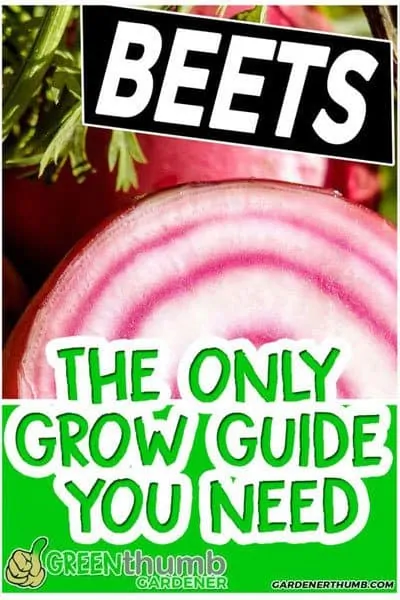
Building your soil with organic materials over the years will help improve your soil structure. Those who have compact soil such as clay may want to use raised beds for this or do some initial tilling of your soil to ensure you have pliable soil for your beets to grow.
When is the best time for Growing Beets
Beets are cool weather plants that can be grown in both the late summer & early fall and early springtimes. In some parts of the country, it can be overwintered with the proper climate or some form of covering.
It definitely requires much cooler weather in order to grow beets successfully. This is a good thing because it also means fewer pests during colder periods.
Beets can be seeded directly in your garden about 30 days prior to your last spring frost date. Most gardeners do direct sowing as you don’t want to disturb the roots too that can happen when transplanting.
There are even some varieties of beets that are hybrid versions that will produce one plant per seed if that concerns you.
One thing you can also do is to try your hand at separating the beets if you plant them in growing pod cells. We have not tried this for ourselves but know of some success stories with other gardeners who have tried this method. That’s the great thing about gardening is that you can always experiment.
I prefer to grow it during Fall for a spring harvest (and sometimes winter harvest if planted late summer) as it is so low maintenance. Our zone (7B, in North Carolina) lends an advantage that allows us to overwinter our vegetables with the addition of a hoop house.
This cures the blues of winter to see healthy greens growing. We do this with quite a few of our vegetables and is easy to do once you get the hang of it. Who doesn’t like growing plants in the wintertime?
Check out this book on Amazon if you are interested in growing vegetables in the dead of winter. The author Elliot Coleman grows vegetables in Northern Maine where the winters are long and cold without any fossil fuels. Yeah, seem impossible. Click here for the latest Amazon prices.

Further Reading
Companion Planting for
Plants that help each other are extremely beneficial to know as a gardener. This companionship helps to repel insects and even large critters. As humans, we have played with nature in ways to compartmentalized gardening. We need to take a step back and learn to promote nature’s balance. One way to do this is to utilize companion planting. Here are some recommendations for beet plants.
Good Companion Plants for Beets
- Bush Beans
- Onions
- Kohlrabi
- Lettuce
- Cabbage
- Brussel Sprouts
Bad Plants to Grow near Beets
- Pole Beans
- Field Mustard
- Charlock
Check out our guide here if you want more information about companion planting for beets.
Caring for your Growing Beets
Beet Water Requirements
Beets require even watering throughout the growing season. Beets do well when it has about 1 inch of water per week. This could be through a combination of rainwater or manual irrigation sources.
The old garden way to monitor the moisture of the soil is the good old sticking your finger in the soil. You don’t want the soil to be too dry. Beets are a root crop so be careful not to get the soil too soggy.
Beet Fertilizing Requirements
Beets are one of those crops that does not need a great deal of fertilizer. Beets are a root crop, so you still do need healthy soil that has plenty of phosphorus and potassium. You don’t need much nitrogen for your beets. Too much nitrogen will only benefit the green tops.
The best way to keep your plants healthy is to feed your soil with organic materials. Soil always benefits from the additions of these materials such as a rotted cow or chicken manure, homemade compost, vermicompost, and other organic compost choices.
Check out some more information about fertilizer in our series found here.
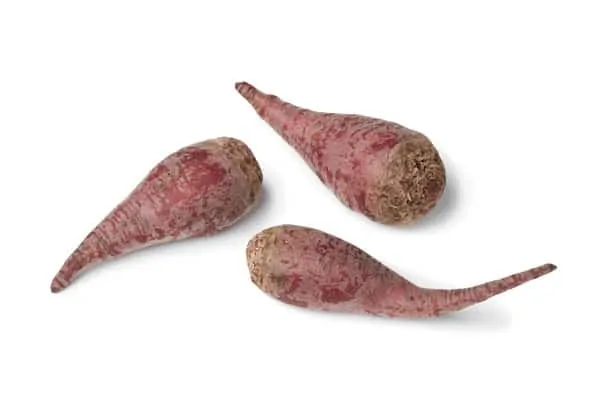
Pest/Diseases of Beets
Beets are one of those vegetables that do not have any problems with pest or diseases. In all the years, we have grown them, we have experienced zero issues. Beets are an amazing crop that is really easy to grow from start to finish. You still may experience some issues from time to time.
Here are a few of the problems you make encounter when growing beets:
Pests that can affect your Beet:
- Leaf Miners – These little guys are small white maggot that feast on the leaf area. Floating row cover would help as a prevention means.
- Flea Beetles – These are little black beetles speckled with orange/yellow stripes. They are usually found on the underside of leaves or close to the soil. They jump like fleas when they are disturbed. The usually dot the leaves with mini dotted holes that can severely stress the plant if left untreated.
- Aphids – You may see these mini little green bugs that just suck the life out of the plants. Usually, they are on the underside of your plants and may also have an army of ants helping them along
- Leafhoppers – They are small insects that suck on the plant saps that are found hopping around. They afflict the leaf and crown of beets and can cause beets to wilt.
Diseases that can affect your Beet:
- Black Root Rot – This disease is characterized by yellowing of young leave veins of infected plants. This causes the main vein to turn yellow and later can lead to defoliation. Dwarfing usually occurs on only one side of the plant.
- Curly top disease – This disease affects the leaves of the beets. The leaves roll inward and start to blister and thicken. This eventually causes the plant to wilt and die. Leafhoppers spread this disease, so you can use row covers to help control leafhoppers from affecting your plants.
- Verticillium wilt – Verticillium wilt may also cause beet plants to wilt and later defoliation. The outer leaves start drying and wilting.
Harvesting & Storing your Beets
Beet Harvest
One of the joys of growing beets is that you can harvest both the greens and the roots. The beet greens are excellent served fresh in salads or cooked like other greens. It can be a little bitter during some periods of its growth, so experiment with different harvest times.
You can begin to harvest the greens about a few weeks before the roots are ready. You can harvest up to 1/3 of the plant without harming the roots.
The roots are best harvested as soon as they reach their maturity, so check your seed varieties growing time. You don’t want to leave them into the ground too long after as they can deteriorate. They are biennial plants, so they won’t flower until another season is passed for climates that have mild winters.
You want to pick the roots when they are about 3 inches in diameter (check varieties are some are larger). Hand pull them carefully and clean off the soil. You want to twist the beet green stems off to leave about an inch of stems to prevent the beets from bleeding.
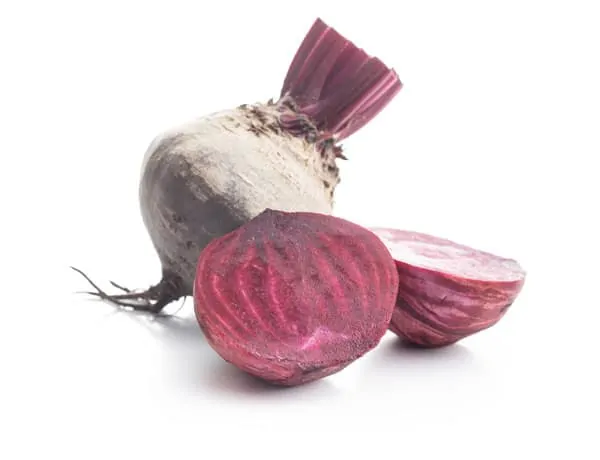
Storing your Beets
There are a few options for storing your Beet plants. Both the greens and the actual root bulbs can be stored in your refrigerator.
- The beet greens can be stored by wrapping them in paper towels and putting in a plastic bag. They usually can keep for about 1-2 weeks after harvesting.
- You can store beets in your refrigerator for about 2-3 weeks if they are undamaged. (Note: they really deteriorate after a few weeks, but have found that roasting them when they are nearing the end of this time period still produces tasty beets.)
- Beets can also be cut up and frozen
- Beets make for an excellent vegetable for pickling or canning
- You can also store beet for up to 6 months. You want to layer undamaged roots in either sand, peat moss, or sawdust in a cool, dark place, preferably in your cellar or basement.
Check out this post here to see some ways to preserve your harvest.
Varieties of Beets to Grow
Here is a list of different varieties of beets to grow in your garden. They are grouped in 2 main varieties of beets: Red Beets and Special Beets.
Special beets include sugar beets and other colored beets. These types of beets are also best for heirloom or open-pollinated plantings to ensure you can save these seeds for planting future beet crops.
Red Beets
- Bull’s Blood Beet – 50 days to harvest. Very sweet and delicious beet variety that are tasty These beets have deep reddish-purple leaves and slightly pink rings inside.
- Chioggia (Bassano) Beet – 60 days to harvest. A favorite Italian heirloom beet that arrived in the USA around 1865. These beets have light red skin and beautiful rings inside. The flesh is very tender, mild, and sweet.
- Crapaudine Beet – 60 days to harvest. Believed to be one of the oldest beets still in existence that dates back 1000 years. A variety that is very flavorful. The roots are very dark, with almost black flesh and sought after by chefs who want real flavor.
- Early Wonder Beet – 50 days to harvest. An old heirloom dated in the early 1800s. Early, smooth, round beet that has tall tender greens. A variety that is excellent for pickling, fresh or cooked.
- Detroit Dark Red Beet – 55 days to harvest. A favorite heirloom variety that was introduced in 1892. This is a very popular, all-purpose red beet. These beets have blood-red flesh that is sweet and tasty. Their tops also make good greens.
- Ruby Queen Beet – 55 days to harvest. These beets have round, smooth roots. Performs well in poor soil; tolerates crowding, holding its shape better than most. This All-America Selections (AAS) winner has been a favorite for several years and used in the commercial canning industry and home food preservers.
Special Beets
- Giant Yellow Eckendorf Beet – 55 to 75 days to harvest. The 1927 Henry Fields catalog said, “Giant, smooth, long roots of cylindrical shape, weighing up to 20 pounds each and growing two-thirds above ground. Solid white flesh with high food value.”
- Golden Beet – 55 days to harvest. This variety dates back to the 1820s or before. These orange-skinned beets have a rich, golden-yellow flesh and very sweet. A beautiful beet that won’t bleed like red beets. The greens are also very tasty. A Green thumb Gardener favorite
- Mammoth Red Mangel Beet – 100 days to harvest. Huge beet that weighs up to 40lbs with large yields. Highly used for livestock feed in the 1800s or picked small for table use.
- Sugar Beet – 95 days to harvest. White-fleshed conical roots are very large and have very high sugar content. Roots frequently exceed two pounds in weight. Mostly used for sugar production or high-calorie fodder food.
- Albino Beet – 55 days to harvest. A pure white, smooth round heirloom beet that originated from Holland. Its white flesh has a unique and tasty flavor in both the flesh and greens. Excellent beet that can also be used for making sugar.
Beet Planting & Growing Guide
Sowing Beets
- Planting Depth: 1/2″(13 mm)
- Soil Germination Temperature: 75-85°F (24-29°C)
- Germination Period: Approx. 5 days
- Sow Outdoors: 3-4 weeks before the last frost
- Sow Indoors: 5 weeks before the last frost
Growing Beets
- Range of pH: 6.0-7.5
- Best Growing Soil Temperature: 65-75°F (18-24°C)
- Spacing in Beds: 1 inch apart in rows about 1 foot apart
- Square Foot Spacing: 9 or 16 per square
- Water Requirements: Moderate and even
- Light: Full sun is optimal for the best yield, but does tolerate partial sunlight
- Nutrients Requirements:
- Nitrogen (N)= low;
- Phosphorus (P) = moderate;
- Potassium (K) = moderate
- Seed to Harvest/Flower Period: 8 weeks

